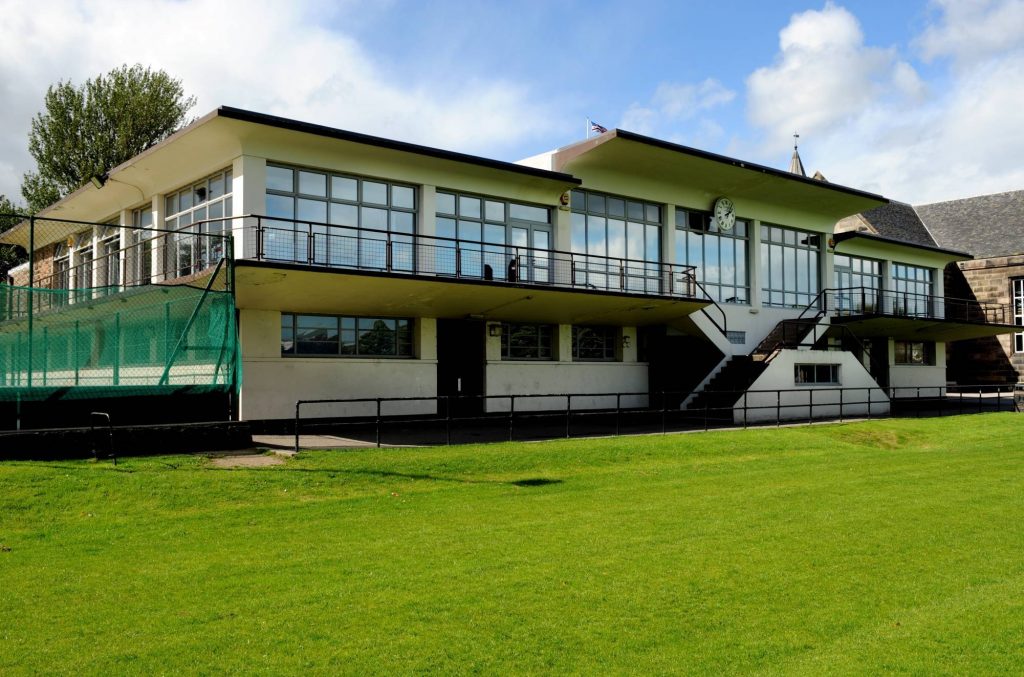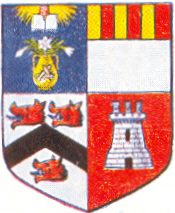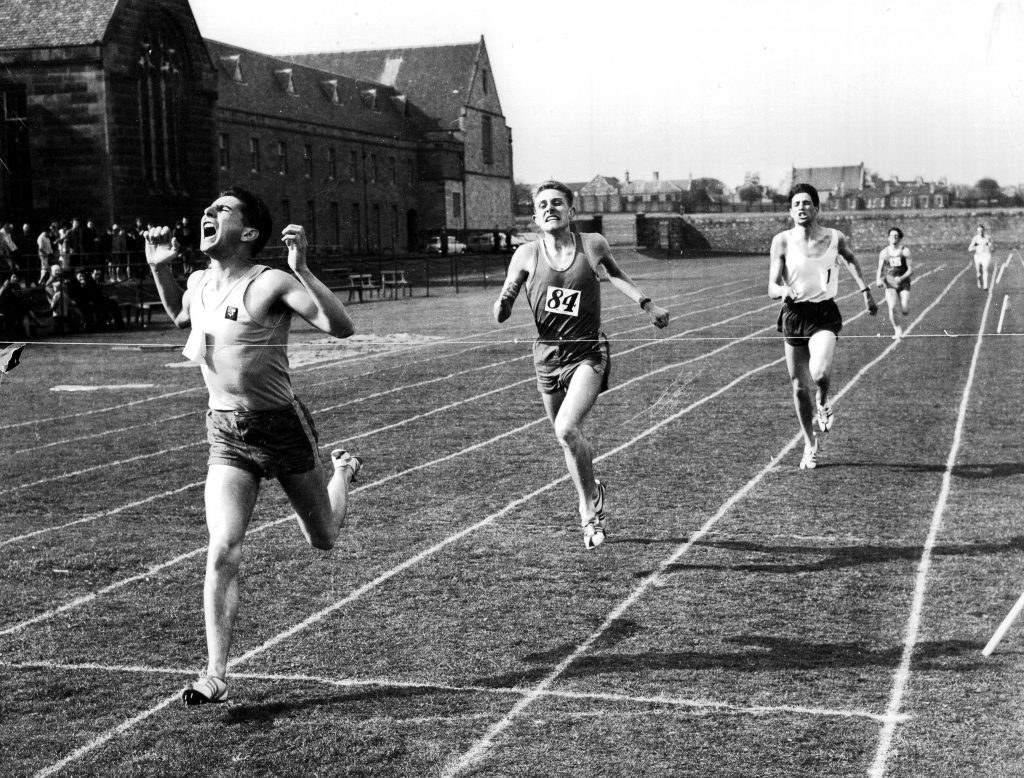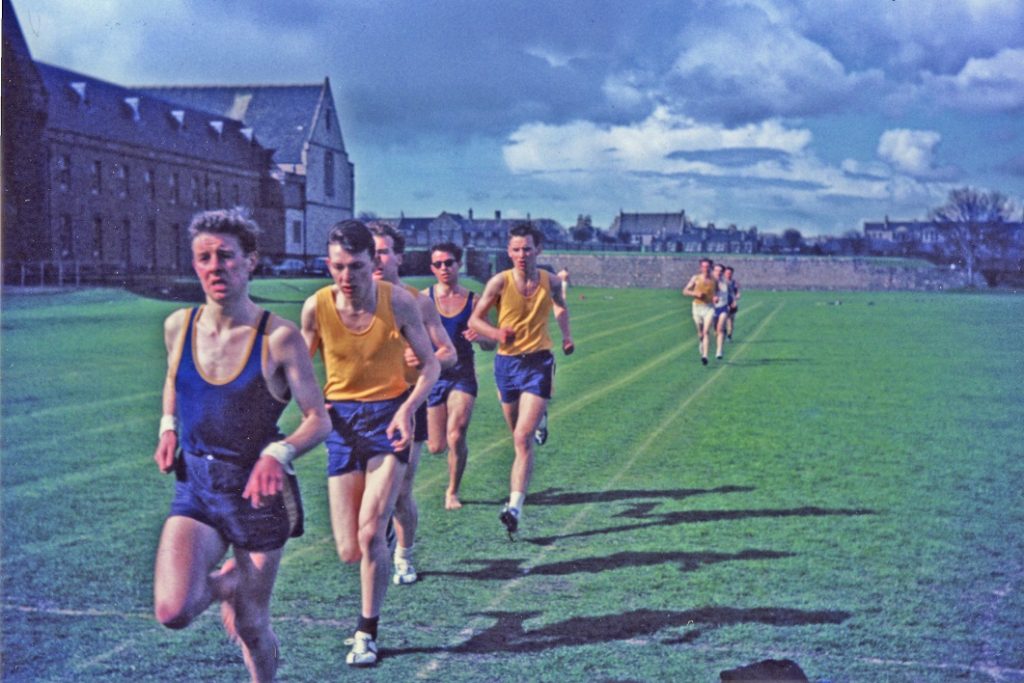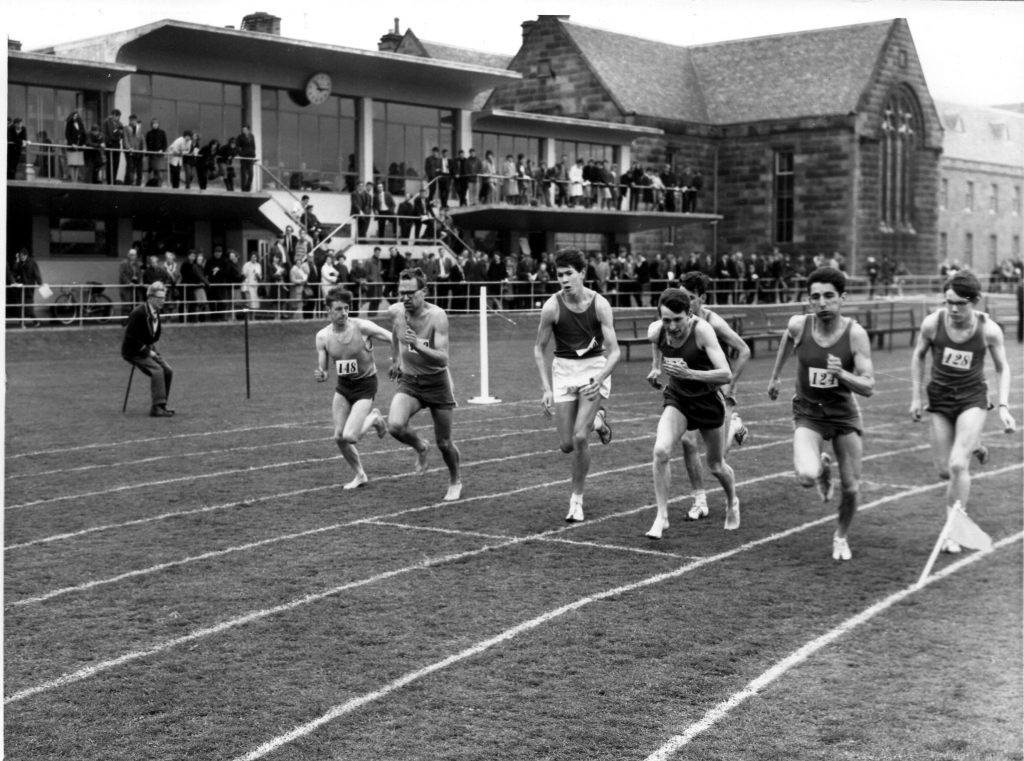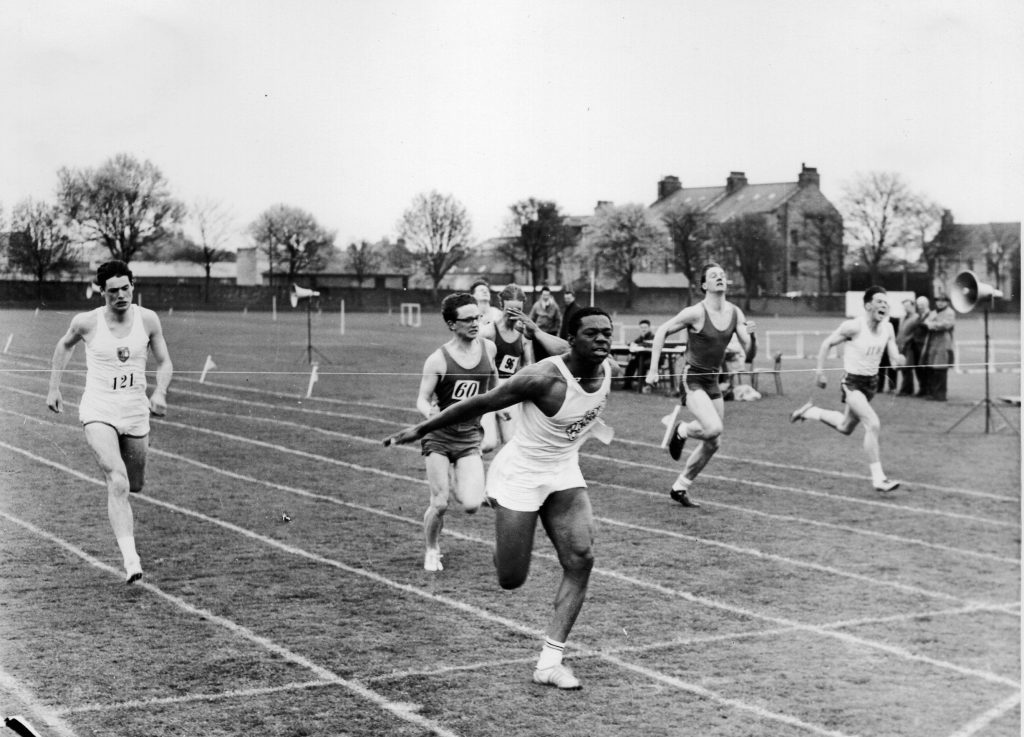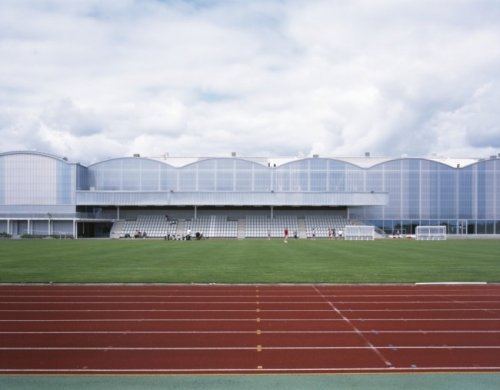Scottish Universities have a strong tradition of track and field athletics and none more so than the four ancients. There were inter university competitions, matches against local clubs and even national university championships. Aberdeen has had several facilities that they used over the years for the Athletics Club. In writing this piece there has been help from Hunter Watson, Fraser Clyne, Bill Ewing and Colin Youngson.
KING’S COLLEGE GROUND PAVILION
All four of the ‘ancient’ universities had their own running track and grounds. The Pavilion at Westerlands in Glasgow is legendary but King’s College in Aberdeen had one every bit as good. Completed on 4th April, 1941 and seen in the photograph above, it even had its own swimming pool. I quote: “The pavilion was built for the King’s College University Athletic Club (more usually referred to as Aberdeen University Athletic Club), but was also required to provide common room facilities for the whole college. Hunter Watson describes the building: “The new building was two storeys high. On the ground floor were changing rooms sufficient to cater for as many as 180 people. Also on the ground floor was a 20 yard long indoor swimming pool with a diving platform at its deep end. On the first floor there was a cafeteria which looked out on to the playing fields and from which the swimming pool could also be viewed. Also on the first floor were squash courts, a private dwelling and two common rooms. Curiously, one of the common rooms was intended for men and the other for women!”
The playing fields themselves were like all the University tracks of the time were of good, well looked after grass and were big enough to hold two rugby pitches, a cricket wicket and a lacrosse field. Fraser Clyne tells us that King’s playing fields opened on Saturday, 2nd November 1889 with a rugby match between Aberdeen and Glasgow Universities. Cricket, rugby and football were there from the start. The first athletics meeting on the grass track was held on 24th May, 1890 with competitions for the championship of the University. Olympians James Tindal Soutter (of Aberdeen University) and Eric Liddell (of Edinburgh University) have both competed there in the past. Hunter Watson takes up the tale: “The initial actions which led to the provision of playing fields at King’s College, Aberdeen took place in 1883. In that year it was established that the University had no intention of erecting any buildings on the site, one which lay immediately to the east of King’s College. Also in that year a committee was appointed to see what could be done.
It was calculated that about £2000 would be required to complete the necessary work and an appeal was made to the graduates of the University for help. With the aid of that appeal and a bazaar, the Committee were able in the summer of 1888 to arrange that the work on the provision of a new playing field be commenced: the ‘Alma Mater’ of 28 November 1888 reported that the ground had “now been laid out”. (The ‘Alma Mater’ is an Aberdeen University magazine which has been published since 1872. Copies for consultation are held in the Aberdeen University Library.)
In the ‘Alma Mater’ of 20 February 1889, it was stated that “The completion of the new Recreation Ground at King’s College may be regarded as a landmark in the history of our ‘Varsity Athletics … What is now needed … is the organisation of the various clubs on a sound financial footing: Good gates are the chief means to this end.” At that time, it appears that numerous spectators could be expected to turn out to watch university students engaged in sporting competitions and also to pay for that privilege.
In the ‘Alma Mater’ of 24 April 1889 it was stated that “The ground, it is fully expected, will be sufficiently firmed by another season to allow of its being freely used.” It was also stated that “The committee suggested the formation of an Athletic Association consisting of the different athletic clubs in the University and to whom the care and custody of the ground should be entrusted.”
It appears that the provision of this playing field at King’s was the stimulus which led to the formation of the Aberdeen University Athletic Association. It also appears that to this Association was given much of the responsibility for the management and maintenance of the new playing field.”
The first Inter University match was held at King’s track on 17th June, 1899 with teams representing Edinburgh, and Glasgow competing with Aberdeen. It was fairly well covered in the ‘Press and Journal’ which started its report:
“Everything conspired to make the Scottish inter-university athletic meeting, which was held at King’s College Grounds, Aberdeen, on Saturday afternoon a decided success. The weather conditions were ideal, the sun shining brilliantly through the heat haze of the early forenoon. The arrangements were most complete; the contests were keen; and the large and fashionable crowd of spectators were rendered picturesque by the bright toilettes of the many ladies who formed a large part of it. The last occasion on which Scottish inter-university sports were held was in 1673; and the present revival, under such successful auspices auguers well for an annual gathering in future. …
The grounds were gaily festooned with ribbons and a number of seats were placed on the terrace from which a good view of the sports could be obtained. During the afternoon, refreshments were provided by Mr W Kennaway, Union Street, in two spacious marquees, while the band of the 1st AREV played the following selection of music ……
The competitors in each event were photographed by Mr James Ewing, Crown Street, and the three teams were also photographed. … The games were under the Scottish Amateur Athletic Association rules. …”
The winners were Edinburgh from Glasgow and then Aberdeen. The reference above to the previous meeting in 1673 is obviously a misprint for 1873, the year in which the Inter-Universities was held at St Andrews. There were only three of the four ancients competing at that time in the Inter-Universities Championships,(Aberdeen, Edinburgh and Glasgow) and the event was held by rota so that they were held in Aberdeen in 1902 (14th June) and 1905 (12th June) with St Andrews being involved for the first time since that meeting in 1873 in 1906. This four-team competition meant that Aberdeen’s next fixture at King’s College was on 19th June 1909: it was the first time the full four university complement was held at King’s. Thereafter the four yearly rota was followed with Aberdeen’s last hosting before the War being 21st June 1913. In this period many more world class athletes were involved at the competition including the wonderful athlete that was WH Welsh.
The Scottish Universities track and field championships were held at King’s on 1 June 1957 when Edinburgh won the inter-universities title with 77 points to Glasgow’s 72, St Andrews 25 and Aberdeen’s 9. The women’s contest was also won by Edinburgh with 40 points from St Andrews 39, Glasgow 29 and Aberdeen 8. JV Paterson set new championship records for the quarter and half mile events of 48.8 sec and 1:52.8, his quarter mile time took 1.4 seconds from the championship record set by Eric Liddell in 1923, while his half mile time was only 0.9 seconds off his own Scottish Native Record which had been set the previous year. WJ More of Glasgow set a ground record of 4:20.8 for the Mile, and A Hannah, Edinburgh won the 440 yards hurdles with a time of 54.1. According to John Keddie in the centenary history of the SAAA, JTA Johnston equalled JGM Hart’s 1949 Scottish Native Record of 15.3 for the 120 yards hurdles which unsurprisingly broke the universities record. R Scott, Glasgow, won the hammer with 142′ 11″. HM Murray of Edinburgh had the satisfaction of breaking the Scottish Native record of 47′ 2″ when winning the Triple Jump with 47′ 3 1/2″but had the disappointment of not being credited with that record because, although resident in Scotland and of Scottish parentage, he had not been born in Scotland. Miss D Will of Aberdeen beat her own discus record with 111′ 5″, and Miss S McLeod, Glasgow, beat Miss J Pringle’s record for the shot by 7″ when she threw 30′.
The ‘Glasgow Herald’ headline read “Day of records at Aberdeen” and it was entirely justified. Paterson’s quarter mile record took 1.4 second from Eric Liddell’s time of 1923 and was a major event.
Hunter Watson, The reigning Scottish Universities Champion did not run in those 1957 championships even though he had been put under some pressure to turn out for Edinburgh. It is understandable why he had been put under such pressure because, one week before the championships he had won the Mile at the Edinburgh University championships in a respectable 4:25.9. Hr had also turned out for Edinburgh at each of the three previous university championships, finishing second to Adrian Jackson in the Mile in 1954 and 1955, and first in both one and three miles in 1956 when Jackson’s priority was competing in an invitation 5000m race in Helsinki. Normally Hunter Watson would have been delighted to represent Edinburgh University on the track, but this time his final examinations took precedence. These were held during the fortnight following the Inter-Universities Championships.
The above photograph was included in the 1953 Coronation Issue of the Aberdeen University magazine, “Athletic Alma.” The photograph was likely to have been taken at the Aberdeen University Athletic Championships which preceded the Inter-University Championships held at King’s in 1953.
In the 1950’s and 60’s the championships were held on a rota in the order Craiglockhart, Westerlands, St Andrews and Aberdeen so that Aberdeen hosted the post war championships in 1949, ’53, ’57, ’61, and ’65. This rota was disturbed in 1969 which was preparation year for the Commonwealth Games in Edinburgh, 1970.
1963: Bill Ewing wins a half mile from Mel Edwards and Graham Reid
Bill Ewing writes that that the ground staff at King’s College were very helpful. They fashioned a “solid water jump” for him just inside the home bend in 1966. He practised his jump technique all Spring, landing on a pad of foam rubber to simulate the water! That season, Bill came second to Gareth Bryan-Jones in the British Universities steeplechase at Birmingham and thinks that the jump practice helped a lot. Bill wonders now what became of that invaluable jump hurdle. In 1967 at Grangemouth Stadium, Bill won the Scottish steeplechase title, just in front of Gareth. Bill states that “King’s will always be my spiritual home for running.”
May 1964. One Mile race led by Bob Jenner, in front of Jim Maycock. Bob and Dave Clark (dark glasses) are both running barefoot on the well-maintained grassy surface. Photo by Neville Jordan.
Above: 1965: Mile start, Bill Ewing second from right.
Excellent view of the pavilion
Below: 1965: 100 yards won by Bernie Nottage
Colin Youngson trained and raced at King’s between 1966 and 1971. “I remember at the end of my first year front-running in a frantic effort to win the AU One mile title but running out of steam and finishing second to Tony Patrick. Then metric distances became standard, so I did manage to win a few 1500m and 5000m races there, either club championships against Jim Maycock or Don Ritchie or ‘Three University’ matches, e.g. AU, Glasgow and Strathclyde; or AU, Edinburgh and Heriot-Watt etc.
One memory is that once, just when I seemed likely to win an inter-university 1500m, an unknown young Strathclyde athlete zoomed past in the final 20 metres – he turned out to be the future GB star Frank Clement!
The Annual Sports Day was a lot of fun. A paarlauf was introduced one year, so that each of a pair of runners took turns to sprint 220 yards then jogged over the middle of the track to take over again. Bob Anderson and I combined to run a 3.57 mile!
Training round the playing fields was great. It was about 660 yards round, so repetitions might involve that distance; or often umpteen 220 yards efforts along the side furthest away from the art deco pavilion; or sometimes horrible flat-out 330s on the track itself. National Coaches John Anderson and Frank Dick both occasionally travelled up north to King’s to organise sessions of 20 second runs or up the clock for many runners.
The Grass Track was very good, flat with a smooth, well-cut surface, ideal for fast times. Near the end of the summer term, a ‘Minnows’ Three Miles’ was popular. The fastest club runners did not count in the results. It was a handicap with the slowest starting first. One year I started last and ended up with a personal best (unusually for me run in bare feet) due to ideal conditions and lots of slower rivals to overtake!
From the mid-1960s there was even an AU half marathon (starting with a lap of the field, then twice round the cross-country course with an extra lap in the middle and one at the finish. First prize was a Sawfish tusk!
For the Annual Students’ Charities campaign, Aberdeen University Hare & Hounds Club in April 1970 decided to attempt a sponsored 72 Hour Marathon Relay round King’s Field, which was timed meticulously. Luckily, conditions were dry. All our first and second team men took part and we succeeded in completing 636 miles at an average speed of almost nine miles an hour. We raised over £300 for the campaign. If you raised £100 you were given a free barrel of beer! The after-event party featured an attempt to drink all three barrels but we did not succeed at that sport. Rather unfairly, the Guinness Book of Records people did not accept our ‘world record’ since they did not think that such a challenge would be popular!
Happy times on a wonderful field and track!”
Aberdeen Sports Village Track
***
BALGOWNIE TRACK
Bill Ewing says that he raced there only once and that it was the worst surface he ever competed on, with its cheap red covering on an unforgiving base.
Mel Edwards says “I believe the track opened 1971/72. An all-weather track, which was a godsend after the cinders (a charitable word for that lumpy track) at the Linksfield Stadium. Balgownie was a rather hard track but welcome all the same.
In 1979, I organised the first Aberdeen marathon and it started and finished there. The runners left the playing fields and did 4 laps of an external road circuit. T he lap was very hilly and the route became known as the Balgownie Alps!
The guest of honour was Jim Peters who came north with his wife Freda. Jim was a former marathon world record holder (2 hour 17 minutes 39.4 secs way back in 1954.).
So, Balgownie was a popular venue, especially for cross country races round playing fields and up and down surrounding hills. It has hosted the East District XC Championships more than once, as well as the Scottish Veterans XC Championships.”
Fraser Clyne says “Balgownie, I am pretty sure, was opened early 1970s. It was there when I started AU in 1973. Always a hard track and very windy.
Graham Laing and I ran 29:22 there one Tuesday night in the AAAC club champs, just running round together (should have gone faster instead of chatting). I did quite a lot of solo 14:20’s there but couldn’t get any quicker.
I vaguely recall outsprinting Colin Youngson there in a 5000m a few days after I ran the Pittsburgh marathon in 1985. 14:54 and 14:55 was all we could manage. Not sure when it stopped being used or maintained regularly, but the superior all-weather track at the Chris Anderson Stadium opened in 1988 so I guess it must have been after then.”
Hunter Watson concludes with a few remarks on Balgownie: “That all-weather track was being used by the North-East Athletics League by 1973. It also began to be used by Aberdeen’s section of the Scottish Young Athletes League in 1975, the year in which Aberdeen joined that league. For a few years in the early 1980s some East of Scotland championship events for younger athletes were held at Balgownie in conjunction with an open athletics meeting organised by Aberdeen AAC. However, Aberdeen University was unable to afford the upkeep of the Balgownie track with the consequence that it deteriorated to such an extent that by 1986 clubs from outwith Aberdeen refused to compete on it. In my capacity as secretary of Aberdeen AAC, as early as 1984 I had begun making representations to the City of Aberdeen to either make a contribution towards the repair of the track at Balgownie or to upgrade the cinder track at Linksfield Stadium. On 1 March 1985 the Director of Leisure and Recreation sent me a letter (see attachment) which made it clear that he had begun discussions with the Scottish Sports Council which, if successful, would lead to the stadium at Linksfield being upgraded to become a Sub National Sports Facility. Happily those discussions were successful though we had to wait until 1988 for the superb track that was eventually laid at Linksfield Stadium. “
